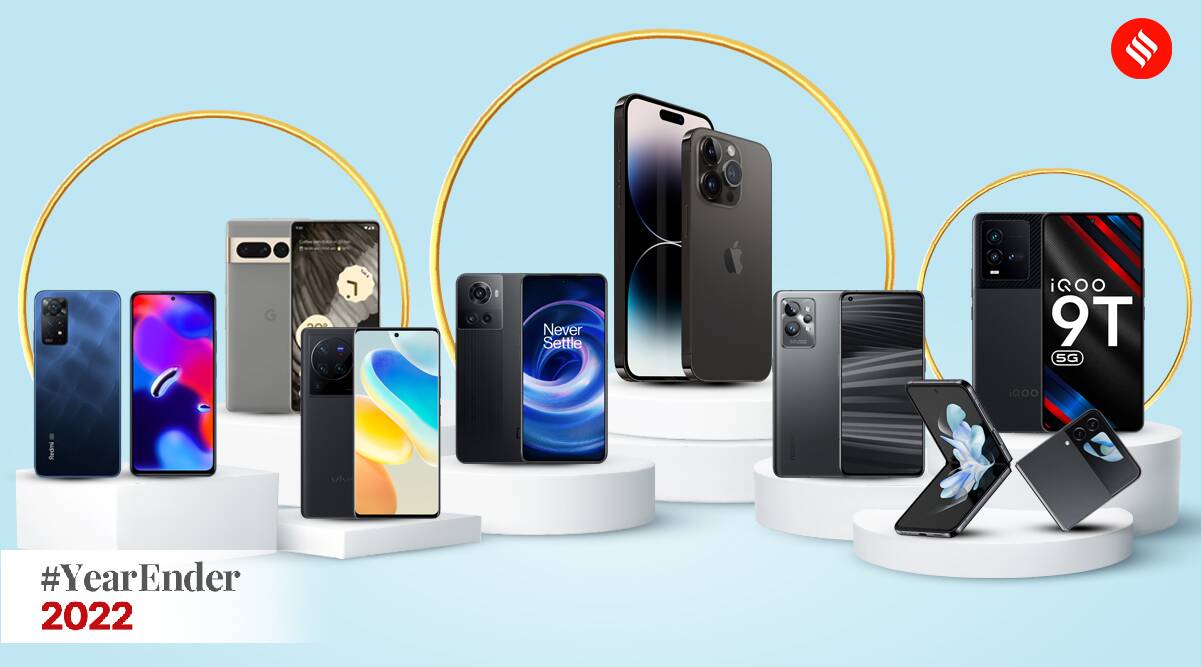
2022 was a tough year for the smartphone industry as a whole. Yes, we saw plenty of new launches, but while the average selling price (ASP) went up in India, the market has started declining. Blame it on macro factors, rising inflation or lack of innovation, the fact is that smartphone sales are down. It doesn’t help that the smartphone itself has not evolved drastically this year. Instead, most companies have gone with the tried-and-tested formula and focused on improving some core features. But it is also fair to say that these days smartphones offer a certain standard in the performance and camera departments. Of course, that makes our jobs as reviewers tougher, especially when it comes to picking ones that stood out this year. Here are our picks for 2022 based on what we reviewed.
Ultra-Premium smartphones (Rs 60,000 and above)
This is one of the toughest categories in smartphones. That’s because most people love to hate these phones, given the price and everyone wants to own one. Admit it, the ‘ultra-premium’ phone is still something most of us aspire towards. Here’s our list of the best ‘ultra-premium phones’ from 2022.
Winner: Apple iPhone 14 Pro Max
Apple stays on top, as the iPhone 14 Pro Max is still the device to beat. It remains the reliable choice for users who want to splurge on their phone and want a device that delivers. More importantly, it has an excellent camera, with a low-light performance that has improved significantly as we saw in our testing. Plus, that Dynamic Island notch was something no one saw coming, and don’t be surprised if you see it on other Android phones next year.
Runner up: Samsung Galaxy Z Flip4
The Galaxy lineup has evolved drastically, with Samsung now focusing on foldable phones in the top slot. And while the Galaxy Z Fold 4 will appeal to those who want something with a bigger display, the Z Flip4 remains one of the most stylish form factors that money can buy for you. In our view, this device packs everything you want, a good camera and performance. And it will set you apart from the crowd.
Special mention: Vivo X80 Pro, Pixel 7 Pro
Two years ago, Vivo’s phones perhaps would not have found a mention in the flagship category. But the company has drastically upped the game on the camera front, and that’s why it is on this list. It really pushed the boundaries of a flagship camera and is close to beating both Apple and Google in some scenarios. The cinematic mode in video recording is also an area where the Vivo X80 Pro excelled.
Finally, we saw the official Pixel series return to India, and yes, the Pixel 7 Pro impressed us with the camera. Pixel 7 Pro might not have the most powerful specifications on paper, but if you want an Android phone with a camera that beats the competition hollow, then the Pixel does that job easily.
Premium smartphones (Rs 40,000 – Rs 60,000)
Sure, smartphone prices have gone up, but you don’t have to pay Rs 80,000 plus to get the best specifications. Companies like OnePlus, iQoo, Realme, and Xiaomi offered plenty of options in this category, often with the best specifications.
Winner: iQoo 9T, OnePlus 10T
The budget flagship approach has been really popular in the past few years, but it seems like the iQOO 9T got the formula just right. Priced at just under Rs 50,000, the phone packed the fastest processor available with other top-notch specs and a sturdy build.
OnePlus took an interesting approach this year, as it introduced the OnePlus 10T with some deviations from what one typically expected. The OnePlus 10T offered the best specifications, a big battery, excellent camera, but the brand dropped the alert slider and Hasselblad branding. This also meant the OnePlus 10T was available at a lower cost than the Pro.
Runner up: Xiaomi 12 Pro
The Xiaomi 12 Pro was also an excellent phone in this category, and frankly an ‘affordable’ flagship. It packed an excellent camera for the price, a 120W fast charger and reliable performance, which made it an easy pick.
Special mention: Realme GT 2 Pro
The Realme GT 2 Pro was powered by the Snapdragon 8 Gen 1, being one of the first devices to feature the chip. It also packed excellent flagship-grade specifications for the Rs 49,999 price tag it launched with. But the highlight here was the paper-inspired back panel design that allowed users to draw on it and more. Making the phone look like a limited-edition piece compared to its rivals, the paper-edition was available at no extra price.
Best mid-premium phones (Rs 30,000 – Rs 40,000)
This particular category had some truly exciting and powerful offerings. And yes, we saw some innovative designs on display in this segment. In fact, brands know that as the ASP rises, they need options in this category, because the seasoned smartphone user is now comfortable spending a little extra to get something unique.
Winner: Nothing phone (1)
The Nothing Phone (1) was never the best specced phone you could buy under Rs 30,000. Instead it focused on two other key aspects – design and a clean software experience. While the experience for many with the latter has been wobbly, five months and even more updates later, the Nothing Phone (1) is a solid device that offers a timeless design, some flashy tricks and most importantly, a reliable user-experience with the promise of more updates than its rivals.
Runner up: Samsung Galaxy A53 5G
Samsung’s A series has also offered capable options in this segment, and the Galaxy A53 was no different. It came with a good camera, good performance, and an excellent display courtesy of Samsung. Plus, this was 5G ready, and Samsung is doing well on the updates front with most of its phones.
Special mention: OnePlus 10R
The OnePlus 10R was one of the first phones in the R series to sport a Mediatek processor, and this one was all about powerful performance in a premium body and package. The OnePlus R series has become a reliable option for those who want the brand, but don’t want to pay the extra premium that the Pro series from OnePlus typically demands. And the OnePlus 10R delivered well on that promise.
Best upper midrange smartphones (Rs 20,000 – 30,000)
This is perhaps the one category that saw a lot of action with brands all competing and offering several options in this price range. And many of the phones came packed with powerful specifications for the price. Here are the ones that stood out for us.
Winner: iQOO Neo 6
The iQOO Neo 6 really solidified the direction the brand’s new lineup was heading towards – best specifications for the price meets an always-improving software experience. The phone had better build quality and specifications than all its rivals, and while it lacked NFC support, it edged out close competitors like the Poco F4 with better cameras.
Runner up: Poco F4
The Poco F4 5G was a surprising one from Poco. It offered a premium design, reliable performance thanks to the Snapdragon 870, and a camera that delivered well for the price. Plus, the price made this an attractive option.
Special mention: Oppo Reno 8
The Oppo Reno8 was another device that offered good specifications and excellent camera for the price with a very premium design. The only flaw that stopped it from being a winner was the slightly higher price.
Best lower midrange smartphones (Rs 15,000 – Rs 20,000)
Admittedly, the mid-budget category has gotten pricier. Most phones with good specifications now cost Rs 15,000 plus, and add 5G to the mix and the price goes even higher. Still, there were plenty of solid options for users in this particular segment.
Winners: Redmi Note 11 Pro+ 5G and OnePlus Nord CE 2 Lite
We have two winners in this segment, with OnePlus coming for the Redmi dominance in a big way. The Redmi Note 11 Pro+ 5G offered all the good features and reliable performance that users want in this particular segment.
Also Read |The 5 biggest scientific breakthroughs of 2022: Fusion energy, ‘life after death’, and more
OnePlus Nord CE 2 Lite offered similar specifications to the Redmi option, was 5G-ready and of course, it came with OnePlus’ OxygenOS which has a better experience to offer in this particular segment.
Runner up: Poco X4 Pro
Compared to the Poco X3 Pro from last year, which was the only device in its class to feature a Snapdragon 8-series processor, the Poco X4 Pro may seem less impressive. However, what the Poco X4 Pro does bring to the table is also unmatched by most phones under Rs 20,000 till date. That includes the best design in the segment, above average specifications for the price and neat cameras.
News Article Source:- Indian Express



Recent Comments